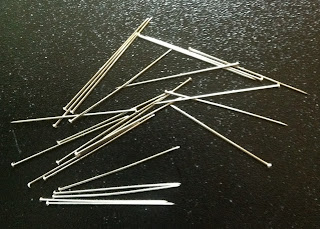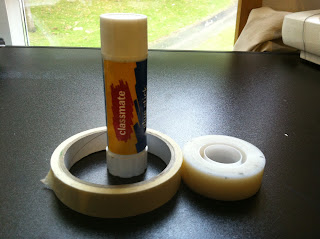Here is a list of some basic and essential pattern cutting equipment that I think is quite useful to have and some can make your tasks easier and more interesting, as well as professional looking. Take a look at the list and see what they are used for. As your skills improve and your projects become more difficult, your need for pattern cutting materials increase accordingly.
- Straight Pins: I prefer to use quite fine silk pins but I do also use the pearl bead headed pins when I need to.
- Pin Cushion or Magnetic Holder: I have both of these. A Pin Cushion is a great way to keep pins close to you at all times as you just pop mine onto my wrist. I made my one by using some old fabric and some wadding- this is also a very cheap way too, so can save you quite a bit of money. If you want to know how to make one, you can click here.
especially on the floor! There are many sites you can get one of these from such as
here.
- Pencils, Rubbers & Coloured Pens: I mainly use 4H pencils as they are much sharper and give a crisp line. I have the mechanical pencils too and I just buy 4H lead. I also use a varity of colouring pens to identify pattern changes and for pattern information.
- Paper Scissors: The size you use is down to preference but I do prefer to use small paper scissors... just make sure that they are nice and sharp!
- Rulers: There are a few rulers that are useful. My favourite ones are a Meter Stick to measure those extra long lengths such as dresses or trousers.
degrees) that measures and squares simultaneously. It is also brilliant for finding the
The Pattern Master, which is quite similar to the set triangle but rather than having two
90 degree angles, it has a straight arm and a curved arm for measuring things like the
neckline. Again, you can also use it to measure seam allowances. If you're a beginner,
you can use general ruler as this isn't expensive but I would advise to get at least a set
square or pattern master at some point further down the line. They are just fab! Click
- Curve Rulers- Again, there are quite a few varieties of the curve rule, of which I have all and I personally find them all great for different things.
The Sleigh Curve is also great for shaping and altering necklines and armholes but it
is also very useful for shaping things like collars, cuffs and pockets. These can be
The Hip Curve not only does what it is supposed to- shape the hipline- but it is also
The Vary Form Curve is fab for blending and shaping armhole and necklines but I
- Awl: This handy little tool is used to pierce a hole in the pattern to indicate the ending of darts. pockets, buttonhole placements and trims. Check out Morplan.
- Push Pins: These are great for pattern manipulation if you don't have an awl and are an inexpensive choice.
- Pritt stick and tape such as masking tape or scotch tape
- Tracing Wheel: There are two types, which can be purchased here;
A Blunted Tracing Wheel, which is used with carbon paper to transfer pattern
shapes to muslin. Although, when i teach children, I do tend to use the blunted tracing
wheel for general pattern cutting as it is safer for that age range.
- Notcher: This cuts a little opening at the patterns edge to indicate a seam allowance, center lines and ease notches. It is also used to identify front and back patterns and can be brought here.
- Measuring Tape: These are essential! I have linen measuring tapes as this type is the most flexible and doesn't tear or stretch. They are 150cm (60") long, which is the most common and have non-fraying, metal tipped ends. It can have metric (cm) and imperial (inches) on the same side or one of each on each side.
- Metal Weights: These can be very useful as they are used to hold the patterns in place for tracing and marking. Click here to have a look.



















i am Ubaid from city Delhi country India
ReplyDeletedoing Pattern Making course
this page is
very informative to me
GOOD LUCK for your work